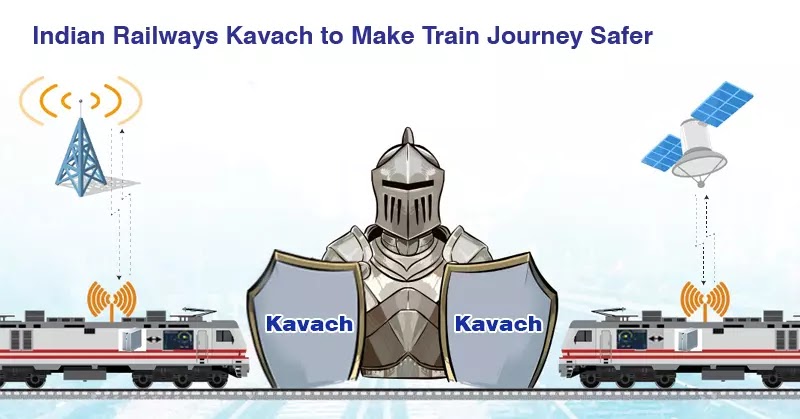In a bid to enhance railway safety and address concerns over increasing accidents, Railways Minister Ashwini Vaishnaw announced the Ministry of Railways’ plans to upgrade its indigenous anti-collision system, Kavach, to 4G/5G (LTE-based) technology.
Kavach, an Automatic Train Protection (ATP) system, has proven instrumental in preventing collisions by activating a train’s braking system automatically if the driver fails to do so.
Background on Kavach
- Kavach, developed indigenously, has been deployed across more than 1,465 route kilometres (rkm), with ongoing work for an additional 3,000 rkm.
- The Ministry of Railways aims to expedite the implementation of this anti-collision system and make it more efficient over longer ranges.
Read more about KAVACH: What is Railway kavach system?
Upgradation Plans and Tenders
- Railways Minister Ashwini Vaishnaw disclosed that tenders for the next-generation Kavach would be released between May and June next year.
- The ministry plans to float tenders for the upgrade of the existing Kavach technology to LTE by the next month.
Capacity Enhancement and Vendor Approvals
- Vaishnaw indicated that the capacity to install Kavach on railway tracks is expected to increase from the current 1,500 rkm per year to 5,000 rkm by 2025-26.
- Six vendors, including Siemens AG and Kyosan Electric Manufacturing Company from Germany and Japan, respectively, as well as four Indian companies, have been approved for the Kavach project.
Cost Efficiency and Live Demonstration
- One of the key advantages of Kavach is its cost efficiency, priced at Rs 40-50 lakh per kilometre, making it 25-33% more economical than its European counterparts.
- Minister Vaishnaw conducted a live demonstration in March, showcasing Kavach’s effectiveness by triggering automatic warning signs when two trains were headed for a collision.
- The technology’s success was highlighted in light of recent accidents, emphasizing the potential for preventing large-scale disasters.
5G Integration and Spectrum Allocation
- Recognizing the broader need for technological advancement, there has been a significant push to enable 5G-based operations in the Indian Railways.
- In June 2021, the national transporter was allocated a 5 MHz spectrum in the 700 MHz band, committing Rs 25,000 crore for the development of long-term evolution over the following five years.
- This allocation positions the railways to embrace modern communication methods and enhance overall operational efficiency.
Intellectual Property Rights and Patents
- As part of its commitment to technological leadership, the Ministry of Railways has established the Gati Shakti Vishwavidyalaya as a center of excellence.
- The ministry has already been granted five patents, signaling a proactive approach to intellectual property rights in the realm of railway technology.
Important Questions Related to Exams
1. What is Kavach, and how does it contribute to railway safety?
Answer: Kavach is an Automatic Train Protection (ATP) system developed indigenously by the Ministry of Railways. It prevents collisions through the automatic activation of a train’s braking system if the driver fails to do so.
2. How is the Ministry of Railways aligning with technological advancements, particularly in the context of 5G integration?
Answer: The Ministry of Railways is aligning with technological advancements by allocating a 5 MHz spectrum in the 700 MHz band for 5G-based operations.
3. How does the Ministry of Railways intend to address capacity constraints in deploying Kavach across the railway network?
Answer: The Ministry of Railways aims to increase the capacity to install Kavach on railway tracks from the current 1,500 route kilometres per year to 5,000 route kilometres by 2025-26.
Static questions Related to Exams
- Former railway board chairman and CEO: Anil Kumar Lahoti
- New Chairperson and Chief Executive Officer (CEO) of Railways: Smt. Jaya Varma Sinha




 ISRO Projects Seven Launches Including U...
ISRO Projects Seven Launches Including U...
 Google Unveils Project Suncatcher to Dev...
Google Unveils Project Suncatcher to Dev...
 AIIMS Delhi Conducts India’s First Dedic...
AIIMS Delhi Conducts India’s First Dedic...







